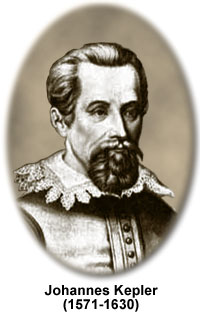Johannes Kepler
(1571-1630)

Johannes Kepler was born on December 27, 1571, in Weilder Stadt, Wurttemburg, in the Holy Roman Empire (now Germany). He was a sickly child with poor parents, but his obvious intelligence earned him a scholarship to the University of Tubingen. At Tubingen, Michael Maestlin, one of the leading astronomers of the day, taught Kepler astronomy. The astronomy of the curriculum was geocentric astronomy in which it was thought that all seven planets--Moon, Mercury, Venus, Sun, Mars, Jupiter and Saturn, moved around the Earth. Maestlin chose to teach Kepler even more advanced astronomy by introducing him to the new heliocentric, cosmological system of Copernicus.
Kepler, who was a profoundly religious man, was persuaded by Maestlin to abandon plans for ordination and instead take up a post teaching mathematics in Graz. In 1596, while at Graz, he wrote the first outspoken defense of the Copernican system, the Mysterium Cosmographicum. Religious intolerance increased in the following years and Kepler moved to Prague to work with the renowned Danish astronomer, Tycho Brahe. He inherited Tycho's post as Imperial Mathematician when Tycho died in 1601. Using the precise data that Tycho had collected, Kepler discovered that the orbit of Mars was an ellipse. In 1609, he published Astronomia Nova delineating his discoveries, which are now called Kepler's first two laws of planetary motion. This work established Kepler as the "father of modern science", documenting how, for the first time, a scientist dealt with a multitude of imperfect data to arrive at a fundamental law of nature. In 1612 Lutherans were forced out of Prague, and Kepler was excommunicated. This caused him much pain but he was never successful in getting this ban lifted even with his high social standing as Imperial Mathematician.
Kepler moved to Linz, and in 1619 he published Harmonices Mundi in which he describes his third law of planetary motion. According to many experts, it was this law--not an apple, that led Newton to his law of gravitation.
In Kepler's book Astronomia Pars Optica, for which he earned the title of founder of modern optics, he was the first to discover many of the common theories of optics. He was the first to use a pin hole camera to investigate the formation of pictures; the first to explain the process of vision by refraction within the eye; the first to formulate eyeglass designs for nearsightedness and farsightedness; and the first to explain the use of both eyes for depth perception.
In his book Dioptrice (a term coined by Kepler and still used today), he was the first to describe real, virtual, upright and inverted images and the concept of magnification. He was the first to explain the principles of how a telescope works, and the first to discover and describe the properties of total internal reflection.
Kepler died in November of 1630 in Regensburg (now in Germany) after a brief illness.
